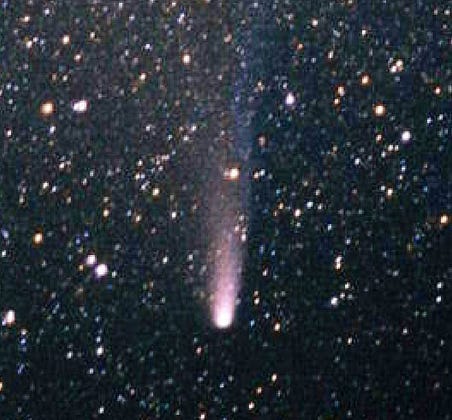
A BRIEF HISTORY OF HALLEY’S COMET
Revised extracts from A Comet Called Halley by Ian Ridpath
(Cambridge University Press, 1985)
Edmond Halley
Edmond Halley
Edmond Halley was perhaps the second-greatest genius in the history of British astronomy. By chance, he lived at the same time as the greatest genius of all, Isaac Newton. In one sense this was unfortunate, for Halley’s reputation has been overshadowed by the stature of Newton. But in another sense it was a happy chance indeed, for had the two not been contemporaries, Halley’s Comet would most likely be known by a different name.
Halley was born in 1656 in Haggerston, then a village north-east of London but now engulfed in the urban sprawl of Hackney. Halley’s father manufactured soap. Why young Edmond turned to astronomy is uncertain, but the comets of 1664 and 1665 may well have played a part. Whatever the reason, his interest in astronomy was already well developed when he went to Oxford University in 1673, where he proved himself a brilliant student. He soon came to the attention of the newly appointed Astronomer Royal, John Flamsteed, with whom Halley observed at Greenwich as a vacation student.
Halley possessed self-confidence and ambition equal to his intellect. Without waiting to finish his studies at Oxford, he persuaded his father to support him on a two-year trip to the island of St Helena in the South Atlantic, from where he planned to catalogue the southern stars as Flamsteed was doing for those in the north. Coming from any other 19-year-old, it would have sounded embarrassingly presumptuous. Halley returned in 1678 with the job accomplished. He was rewarded with the accolades of the Royal Society and its patron, King Charles II, who ordered Oxford University to award Halley his master’s degree.
Comets in view
Significantly, a comet was in the morning sky at the end of 1680 when Halley left on a trip to Paris. By the time he arrived in Paris the comet had rounded the Sun and reappeared impressively in the evening sky. It was the talk of the city but it was not generally realized to be the same comet seen a few weeks earlier. Even the great Isaac Newton, watching from Cambridge, thought there had been two separate comets. Halley tried to calculate the comet’s motion, taking Kepler’s word that such a body should travel in a straight line. Not surprisingly, he failed. The matter rankled with him, for he was not a man to be easily beaten.
Back in London in 1682 Halley married and, as if by an act of Providence, another comet appeared. This was the comet that would one day bear his name, although Halley could never have guessed that fact as he scribbled down observations of it at his new home in Islington. ☄
Saying hallo to Halley
Traditionally the name Halley has been pronounced to rhyme with valley, as in this Royal Astronomical Society drinking song from 1910:
Of all the comets in the sky,
There’s none like Comet Halley.
We see it with the naked eye
And periodically.
The first to see it was not he,
But still we call it Halley.
The notion that it would return
Was his originally.
Many people nowadays say ‘Hailey’, a legacy of the 1950s rock group Bill Haley and the Comets. To add to the confusion, some historians have suggested that Halley might have pronounced his own name ‘Hawley’. Unfortunately, there are no known Halleys descended from the great astronomer to help us.
At the last return of the comet in 1985 I telephoned representatives of 36 Halley families and asked them how they pronounced their own name. Two said it ‘Hailey’, and two others said ‘Hawley’. The rest, 89 per cent of my sample, used the traditional pronunciation, which is also used by all astronomers engaged in comet study. Whichever way Halley himself pronounced his name, the traditional pronunciation clearly has the support of the vast majority of present-day Halleys. ☄